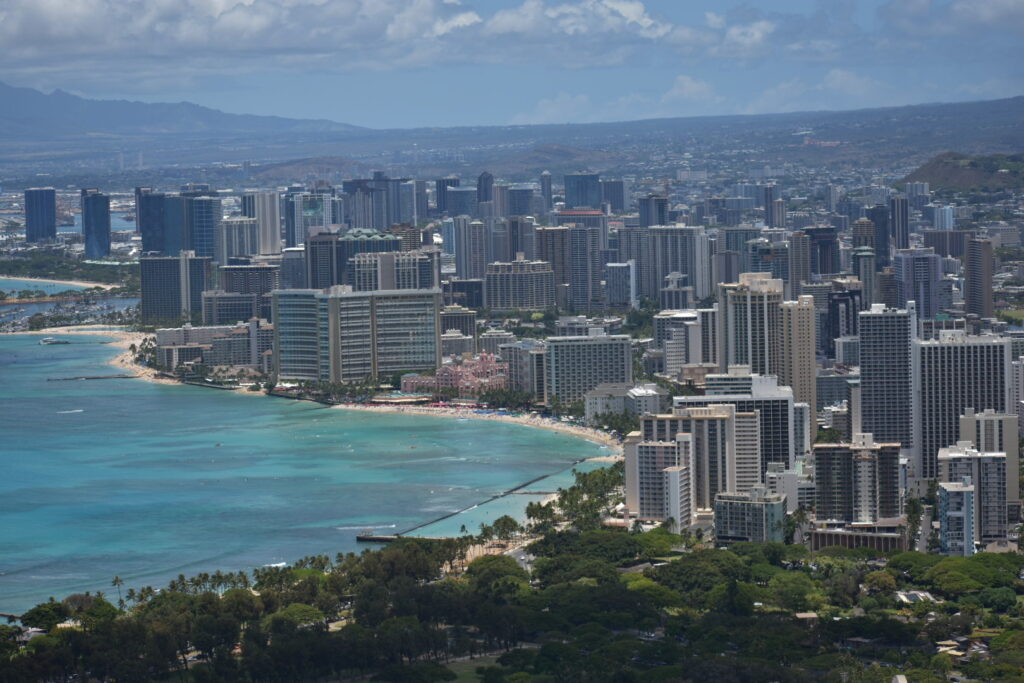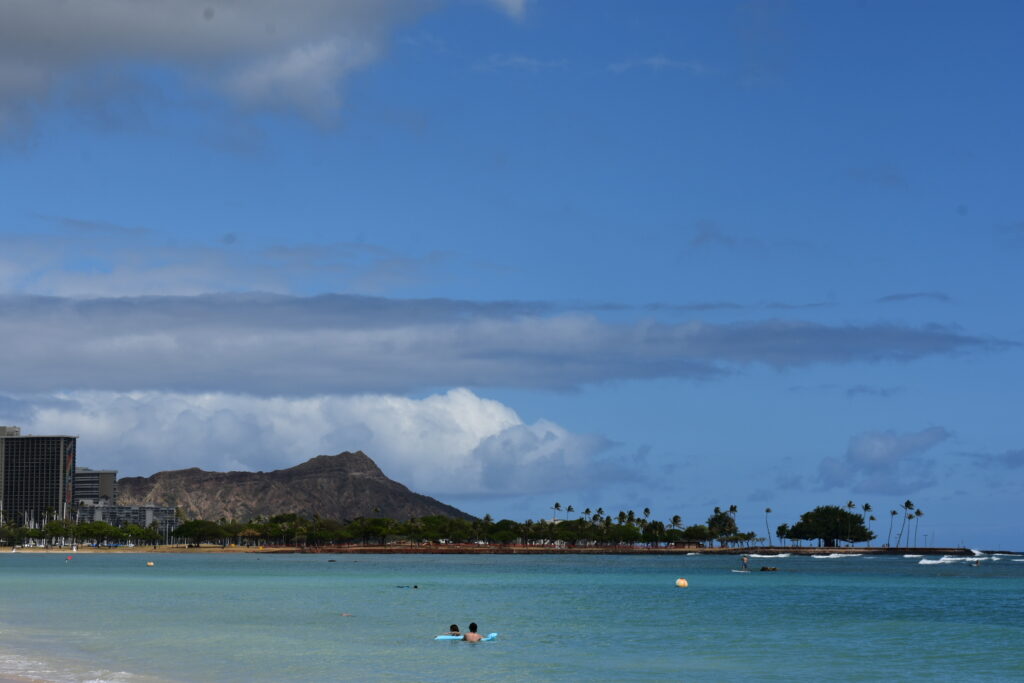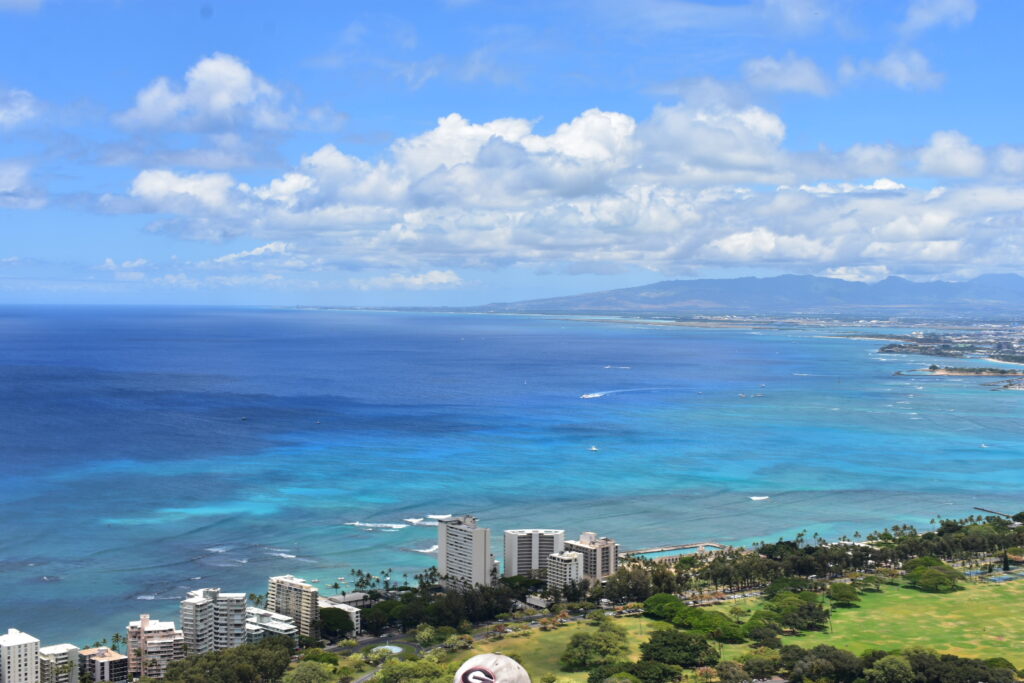In the heart of Hawaii lies a towering landmark that graces the skyline of Waikiki, making it visible from virtually every corner of the city. This prominent peak, renowned as Diamond Head, holds a place of honor in countless photographs and films depicting the essence of Waikiki. Rising dramatically from the southern shores of Oahu, it stands as a testament to both the island’s geological legacy and its rich historical narrative. Formed over a staggering span of 300,000 years amidst intense volcanic activity, Diamond Head’s enduring presence is a testament to the powerful forces that shaped the Hawaiian archipelago. Its distinctive moniker, dating back to the 19th century, stems from a captivating historical anecdote: British sailors, upon sighting the mountain, were captivated by the glimmering calcite crystals within its rock, erroneously believing them to be diamonds. Today, Diamond Head stands not only as a geological wonder but also as a captivating symbol of the natural and cultural tapestry that defines Hawaii.
Unveiling a Dormant Giant – Diamond Head
Diamond Head, though now a dormant sentinel, bears the enduring marks of its volcanic origins. Over 150,000 years ago, this majestic peak was a dynamic force, shaping the landscape of Oahu through eruptions that resonated for miles. These cataclysmic events have left an indelible mark on the island, influencing the very terrain that we marvel at today.



The legacy of Diamond Head’s eruptions is unmistakable. Its slopes, once a tumultuous cauldron of molten rock, now cradle a vibrant tapestry of lush vegetation, offering a stark contrast to the rugged, ash-colored exterior that hints at the mountain’s fiery past. Layers of volcanic ash and basaltic rock define the cone’s topography, an enduring testament to the explosive forces that once roared from within its depths.
While Diamond Head now rests in a state of dormancy, the question of potential reactivation inevitably arises. Scientists assert that, while the likelihood of another eruption is extremely low, it remains within the realm of possibility. As with all volcanic formations, the potential for reawakening is an inherent aspect of their nature. Nevertheless, extensive monitoring and scientific knowledge offer reassurance that Diamond Head’s slumber is likely to persist for millennia to come, allowing visitors and residents alike to appreciate its captivating beauty and historical significance without imminent concern.
A Bastion of Defense
Diamond Head’s strategic significance did not go unnoticed in the annals of military history. As the 20th century dawned, the U.S. military saw the immense potential in its commanding location. This led to a transformation of Diamond Head into a formidable coastal defense station, solidifying its role as a crucial asset in safeguarding Oahu’s shores. The station was equipped with bunkers, observation posts, and other defensive structures that stand as silent sentinels to this day. These remnants offer a tangible link to the past, inviting visitors to explore the vestiges of this once-bustling military installation as they ascend the trail leading to the summit.

During the tumultuous events of December 7, 1941, when the Japanese launched a surprise attack on Pearl Harbor, Diamond Head played a critical role. Serving as a Navy post, it was instrumental in the defense efforts against the invading forces. From its elevated vantage point, the military personnel stationed at Diamond Head had a strategic view of the unfolding chaos, enabling them to coordinate defensive measures.
After the turbulent years of World War II, Diamond Head continued to serve in various capacities, eventually being decommissioned in 1955. Although the military structures have ceased their active duty, they remain standing as enduring monuments to the dedication and sacrifice of those who served in defense of Oahu’s shores. Today, they offer visitors a tangible connection to this pivotal chapter in Hawaiian and American history, allowing them to step back in time and envision the critical role that Diamond Head played in safeguarding the island.
Ascending the Heights of Diamond Head
Standing tall at 762 feet above sea level, Diamond Head’s ascent beckons both seasoned hikers and casual enthusiasts alike to take on its rewarding challenge. Spanning approximately 1.6 miles round trip, the trail guides climbers through a mesmerizing landscape of switchbacks and tunnels carved into the ancient volcanic rock. While the incline may present moments of steepness, the path is meticulously maintained and equipped with strategically placed railings, ensuring a secure and enjoyable climb.
Upon reaching the summit, the endeavor is met with a breathtaking reward. A sweeping panorama unfurls in every direction, offering unobstructed views of the Pacific Ocean’s glimmering expanse, the bustling cityscape of Honolulu, and the lush, undulating landscapes of Oahu. The sight of Waikiki Beach, cradled by the glistening waters of the Pacific, is a particularly awe-inspiring highlight. From this vantage point, Diamond Head bestows a perspective that transcends the ordinary, leaving visitors with a profound sense of wonder and appreciation for the unrivaled natural beauty and historical significance that define this remarkable peak. Each step taken on the trail is a journey through time, weaving together the geological wonders and cultural narratives that make Diamond Head an enduring emblem of Oahu.
Before you climb Diamond Head
For those eager to embark on the exhilarating ascent of Diamond Head, it’s wise to come prepared for the rewarding but moderately challenging trail. The path winds its way upwards, encompassing steep inclines and narrow corridors that once served as part of the old military base. To ensure a safe and enjoyable climb, consider wearing comfortable, sturdy footwear with good traction to navigate the terrain. Bringing along a refillable water bottle is crucial, as the tropical sun can be intense, and hydration is key. Sunscreen, a wide-brimmed hat, and lightweight, breathable clothing will also help protect against the elements. It’s advisable to set out early in the day to avoid the heat and potential crowds, and carrying a small backpack with essentials like snacks, a camera, and a map can enhance the experience. Additionally, being mindful of your physical condition and taking breaks when needed is essential, especially during the steeper sections. With the right preparations and a sense of adventure, ascending Diamond Head promises not only stunning views but also a memorable and invigorating experience.
In conclusion, climbing Diamond Head is a journey through time, from its volcanic origins to its military legacy and its current status as a cherished hiking destination. The challenge of the ascent is met with unparalleled views that serve as a testament to the geological and cultural richness of Oahu. For those seeking adventure, history, and breathtaking vistas, Diamond Head is a must-visit destination on the island of Oahu.






